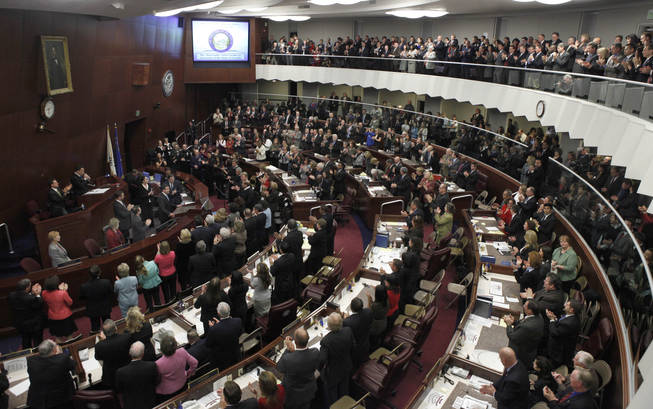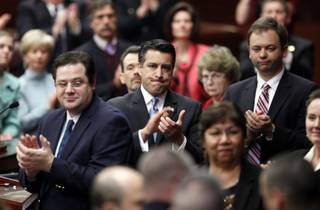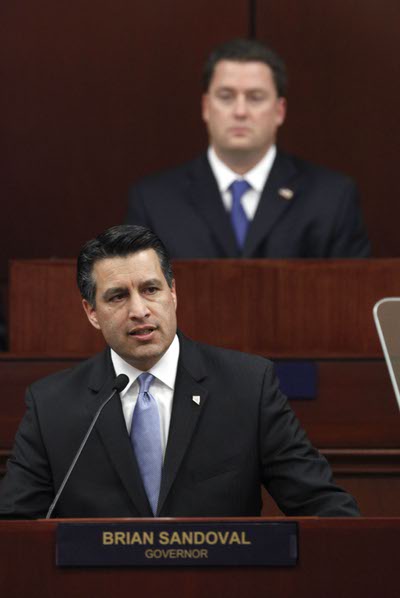
AP Photo/Rich Pedroncelli
Lawmakers and guests give Gov. Brian Sandoval a standing ovation for remarks made during his first State of the State address given before a joint session of the Nevada Legislature in Carson City on Monday, Jan. 24, 2011.
Tuesday, Jan. 25, 2011 | 12:22 a.m.
Grade Sandoval's State of the State address
- What grade would you assign to Gov. Brian Sandoval's State of the State address?
- F — 37.2%
- D — 20.2%
- A — 16.6%
- C — 15.5%
- B — 10.5%
- What is your ZIP code?
- What is your political party affiliation?
- Democrat — 45.4%
- Independent — 24.3%
- Republican — 22.4%
- Other — 3.6%
- Libertarian — 2.4%
- Green — 1.1%
- Tea Party of Nevada — 0.7%
- Independent American Party — 0.1%
This poll is closed, see Full Results »
Note: This is not a scientific poll. The results reflect only the opinions of those who chose to participate.
Beyond the Sun
Sun Coverage
Sun Archives
- Scott Dickensheets: Imagine the state of the state two years down the road (1-24-11)
- State of the State: How doors could open for Nevada (1-24-11)
- Is Brian Sandoval’s ‘shared-sacrifice’ budget the solution to state’s economic woes? (1-23-11)
- Most vulnerable await budget cuts with trepidation (1-23-11)
- Increasingly worried liberals seek pushback on Sandoval budget (1-21-11)
- Construction industry: Raise taxes for job growth (1-20-11)
- Groups seek higher taxes on tobacco and gasoline (1-20-11)
- Sandoval warns of consolidation, job losses in state government (1-19-11)
Everyone knew Gov. Brian Sandoval would present a budget without tax increases. He repeated that promise umpteen times over the past year.
What was surprising was that his budget, unveiled Monday, looks much like the one proposed by his predecessor, Jim Gibbons, in 2009 that was rejected by the Legislature: short on bold initiatives, long on kicking the proverbial can down the road by dodging permanent solutions.
Sandoval — who arrived at the state Capitol with a stellar reputation, an experienced staff and the endorsement of more voters than any other politician in November — not only kept his promise not to raise taxes but actually lowered them for Nevada’s largest employers.
He failed to keep his promise of limiting general fund spending to under $5.3 billion — the amount of tax revenue projected by the state’s official forecasters. (Total general fund spending would be $5.8 billion under his spending plan.)
How did he accomplish his task? With cuts to K-12 schools, higher education, state worker pay, combined with the sleights of hand that have become familiar in recent years. The Sandoval administration called them $1 billion in “revenue reallocations.” They include:
• Selling bonds against future tax revenue to raise $190 million.
• Using $425 million in school construction funds to pay for education operating costs.
• Redirecting $200 million in hotel room tax revenue set aside for education to the general fund.
Sandoval’s aides tried to spin it as a more thoughtful approach than Gibbons’. And in his speech, Sandoval said “spending cuts alone could not do the work of balancing the state budget in a reasonable, thoughtful manner.”
His budget does restore some cuts that had been proposed to health and human services. But more notably, it leaves tough choices to others to make:
• He won’t have to be in the room when school boards decide how to absorb cuts, either through teacher layoffs or pay reductions.
• Higher education bureaucrats and the elected Board of Regents will make decisions on closing departments and/or raising tuition and fees to deal with a cut to funding of 22 percent.
• Clark and Washoe counties will have to decide how to fund their child welfare systems — child abuse investigations, foster care, and adoptions — with less money. In the past the state and county operated them jointly. Now, the state will issue a “block grant” that will allow more flexibility in how it’s spent, but in the case of Clark County, totals are about $19 million less than the county requested. The county will decide how to provide those services with less money.
Here is how Sandoval’s spending plan plays out:
K-12
Nevada, which has always hovered near the bottom of spending per pupil nationally, would spend $270 less per pupil, or $4,918.
The governor has proposed a cut to schools of 9 percent. But he reduces that to 5.2 percent by taking money from school district construction coffers to pay for operations. Additionally, he shifts to the general fund $200 million in room tax money earmarked for schools.
Not since 2007 has per-pupil funding hovered below $5,000. And since then the system has seen the addition of 12,000 students and costs increase on things such as power, according to the Nevada Education Department.
He said he hoped to use the room tax revenue to fund a teacher performance program, but “we must live with current realities.” Instead, a teacher performance program will be funded with $20 million.
Higher education
Sandoval is cutting more than $280 million in state spending on higher education.
But he is also providing the system with an ongoing source of revenue from local governments, diverting 9 cents of Clark and Washoe counties’ property taxes to higher education.
The property tax — it equals $121 million over the next two years — collected in Clark County will fund UNLV while Washoe County’s revenue will fund UNR.
The shift is permanent, and the amount will rise and fall with property values.
According to Sandoval’s numbers, the higher education system would lose 18 percent of its funding compared with the past two years.
Students could bear the brunt of the cuts as Sandoval tries to wean the system off state support. He’ll be giving universities more control over revenue raised from tuition increases.
Good news for students: Sandoval’s budget preserves the Millennium Scholarship until 2016.
Local governments
Sandoval’s budget would take money from local governments to fund some state services and end state funding for other services.
For example, the state would take county money for elder protective services and youth parole services. Sandoval would also eliminate state funding for some programs jointly run by the counties and the state, such as juvenile justice programs and emergency assistance for people on welfare. It would be up to the counties whether they would cut or maintain those services, administration officials said.
Together, those closed the state’s budget hole by $136 million.
That’s on top of the governor redirecting $131 million from Washoe and Clark counties property taxes to higher education and the $425 million taken from 12 school districts’ school building and maintenance accounts.
Health and human services
The department that makes sure the state’s needy, elderly, disabled and mentally ill are taken care of will lose only $10 million.
The department’s budget will be relatively flat compared with the last biennium. But that doesn’t take into account a spike in caseloads as the economy has plummeted.
To offset the expense of more people on Medicaid, food stamps and temporary assistance rolls, Sandoval is proposing $275 million in cuts to existing services.
Doctors who treat Medicaid patients will see their reimbursements cut by 15 percent to 25 percent. State funding for mental health services, such as triage centers and psychosocial rehabilitation will be eliminated. A property tax assistance program for senior citizens will be done away with.
Sandoval avoided many of the grim cuts agencies had proposed to Gibbons: families with autistic children will still receive assistance, as will traumatic brain injury patients; personal care attendants will still be funded, keeping elderly and disabled patients out of nursing homes; and Medicaid patients will still receive dentures, prosthetics and hearing aids.
Economic development/business
Sandoval sent a business-friendly message: His budget will keep taxes low. For the state’s largest employers and on sales tax, the rates will actually drop to pre-2009 levels when temporary tax increases expire June 30.
It also adds $10 million in economic development incentives to attract businesses to Nevada.



Join the Discussion:
Check this out for a full explanation of our conversion to the LiveFyre commenting system and instructions on how to sign up for an account.
Full comments policy